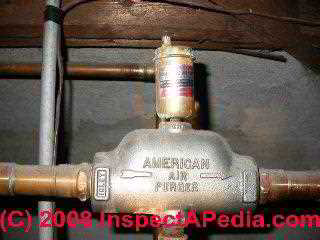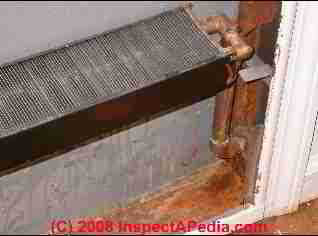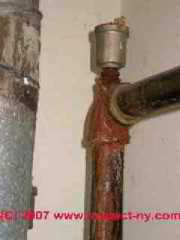 Definition & Function of Hot Water Heat Air Bleeder Valves
Definition & Function of Hot Water Heat Air Bleeder Valves
- POST a QUESTION or COMMENT about how air vents work on hot water heating systems & how they are used
A guide to using air bleed valves to get rid of unwanted air in hot water heating systems: fix cold or noisy hot water heating radiators or baseboards.
Here we explain how to diagnose and repair problems with air bleed valves and we describe methods used to remove un-wanted, air from noisy or air-bound hot water heating system pipes, radiators, convectors, and baseboards. We illustrate how to buy and add air bleeders at baseboard elbows using a baseboard tee and air bleeder valves.
InspectAPedia tolerates no conflicts of interest. We have no relationship with advertisers, products, or services discussed at this website.
- Daniel Friedman, Publisher/Editor/Author - See WHO ARE WE?
What Are the Functions of Hot Water Heating System (hydronic heat) Air Bleeder Valves?
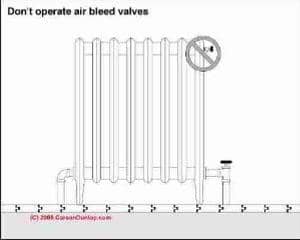 Air bleeder valves, both manual and automatic, are used forced hot water heating systems to remove un-wanted air from the heating distribution pipes and radiators.
Air bleeder valves, both manual and automatic, are used forced hot water heating systems to remove un-wanted air from the heating distribution pipes and radiators.
Carson Dunlop Associates' sketch (left) shows a common location for the air bleed valve on a cast iron radiator. The advice to leave this valve alone is intended for home inspectors who don't want to risk spilling water on someone's floor or opening a valve to find that they can't close it again. But if your hot water radiator or convector is staying cold even though the heating boiler is running and hot, it may be air-bound and you'll need to bleed out the air.
Why is it necessary to get this air out of heating lines?
Air trapped in hot water heating piping, radiators, baseboards, or convectors makes the heating system noisy with gurgling or bubbling sounds if there is just a little air in the heating system.
But if the volume of air becomes too great, the heating system will simply stop delivering heat to the occupied spaces, some or all of them, in the building. Why? A heating circulator pump is capable of pushing water around in the loop of heating baseboard but is often not capable of overcoming a section of baseboard that contains a large bubble of air. It's necessary to remove such air blocks. If air blocking has been recurrent a previous owner may have installed air bleeders at strategic points.
See AIRBOUND HEAT SYSTEM REPAIR by WATER FEED VALVE if the cold radiator, convector, or baseboard problem seems to affect all of the heating radiation devices on all or part of an individual heating piping loop or zone.
What are the Types of Air Bleeder Valves and Where are they Found on Hot Water Heat Systems?
Automatic air purge devices (photos at page top & just above and again below) are available and are usually installed right at the heating boiler but sometimes additional ones are needed at higher levels in the building.
The two most common locations for automatic air bleeder valves on hot water heating systems are on top of the heating boiler itself (photo below left), or on a special air-scoop and air purging device found on the hot water heating piping just over or near the heating boiler (photo below right).
Manual air bleeder valves (photo below)
can be opened slightly and carefully, to permit air to escape. Some heating convectors may have a tapping closed by a plug (photo at left) where an air bleeder valve can be installed - much more convenient than having to remove and replace the plug itself to get air out of the heating system piping.
[Click to enlarge any image]
As soon as water starts coming out of an air bleeder valve it can be closed.
The most common location for manual air bleeder valves on hot water heating systems are on heating radiators and convector units (every one), and at the ends of heating baseboard sections where there has been a previous problem with becoming air bound.
Identification Photos of 5 Types of Hydronic Heating (hot water heat) air vents or air purge valves & where to buy them
We distinguish among several types of heating system air bleeder valves or air vents as follows:
- AIR BLEEDER VALVES, MANUALor vents - (shown below in photo and sketch).
Manually operated air vents found on heating baseboards at high-end elbows (baseboard tees shown at left) or at the upper end of a hot water radiator or convector are opened with a key or screwdriver to vent air from air bound (cold) or noisy heating radiators & piping.
At least some manual air vents include a tiny "spout" not just a hole through which to bleed air. The spout allows you to catch any water that squirts out of the vent during the bleeding process.

and our second image below shows is a newer type of baseboard tee that replaces the older model shown at the left side of our little photos above). We discuss baseboard tee installation and repair below.
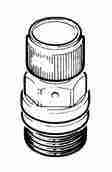
- Hygroscopic automatic air bleeder valves or vents - (Sketch, above) look like a manual air bleeder valve but are left open and are designed to vent air automagically from the system.
Watch out for leaks and corrosions and replace any of these valves that are leaking. Automatic radiator vents and hygroscopic air bleeder vents will be provided with air vent holes but no little spout.

- AIR BLEED VALVES, AUTOMATIC float-type or air vents (photo, above, third from left) - use a larger canister and float design and, provided you leave the valve cap open, are designed to automatically vent air from the system. We install float type air vents at high points at or near the heating boiler.
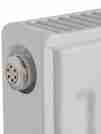
- Hot Water Heating Radiator vents or air bleeder valves include both manual and automatic air vents for hot water heating systems (image of a modern European automatic radiator vent is at above 3rd from right) in the same manner as air vents on heating baseboards and convectors shown in the article above.
These simple hot water heating radiator vents are opened with a key or screwdriver to vent air from an air-bound hot water heating radiator. Two very common hot water radiator air bleeder valves are shown at above right and 2d from right.
Also see RADIATOR VALVES & HEAT CONTROLS
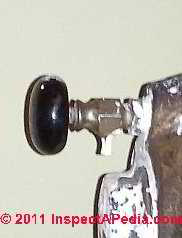
- STEAM RADIATOR VENTS are not discussed here but are detailed
at STEAM HEATING SYSTEMS.
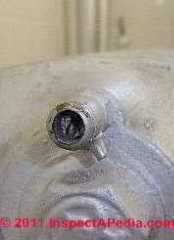
Where to buy air bleeder valves: see your local plumbing & heating supplier. F
or a list of air eliminator, air purge, air bleed valve manufacturers & sources
Where to install air bleeder valves:
see AIR BLEED VALVE INSTALLATION
...
Reader Comments, Questions & Answers About The Article Above
Below you will find questions and answers previously posted on this page at its page bottom reader comment box.
Reader Q&A - also see RECOMMENDED ARTICLES & FAQs
On 2018-01-21 - by (mod) - bleeding air out of radiators reduces noises
Joey
That's a good suggestion, give it a try.
On 2018-01-20 by Joey
I'm the owner of a 2 story residential home. I've been having a kettling sound coming from the boiler all winter. Bleeding the rads results in a temporary improvement of the noise level.
3 of the 4 rads on the upper level have Made O Mist automatic bleeder valves installed. I think one of them is probably allowing air in to the line when the pressure drops. Would it make sense to increase the pressure, bleed out the air, then close the bleeder valves until I can change them out in the summer? Is there any danger in doing so?
On 2017-02-11 - by (mod) - banging bedroom radiator noises
Pete, you might want to search InspectApedia.com for BANGING STEAM PIPES to see the diagnosis and cure for that problem - typically due to condensate not returning or not draining from radiators. Yes a faulty condensate return control or steam trap could be the problem.
Thermal expansion of heating pipes can make noises where pipes pass through walls, floors, ceilings, as they pipes heat and cool. Increase the clearance and insulate the passage opening in that case.
On 2017-02-11 by pete
I'm a new owner of a third (top) floor unit of an 80-year-old 54-unit two-pipe steam building with original CI radiators. T
hese all have Honeywell (old Braukmann) manual controllers atop on the near side and Hoffman 17C thermostatic traps below far side. Bedroom radiator is banging apparently even with controller fully closed. I can't tell from a description of the noise whether it sounds more like pipe expansion or trapped air.
It seems to happen whenever there is call for heat. There is no obvious bleeder valve on this leg of the system, but on the top of every radiator (opposite the valve side), there is a small (1/4") slotted headless screw tapped into the radiator body just above the top unit-coupling nut. Three questions:
(1) If pipe expansion, is there anything that can be done?
(2) Isn't the Hoffman 17C a condensate drain? Assuming that is working right, shouldn't that be taking care of any hammer inside the radiator caused by blocked condensate? How can I test this?
(3) I am unfamiliar with how two-pipe steam systems behave;
is it possible the hammer problem is caused by these Honeywell-Braukmann controls being only partway open? How is it that adjustable controllers work on two-pipe steam?
Question: can I change a manual air bleeder to an automatic one
Can an automatic bleeder be screwed in where the manual bleeder is on my radiator or will i have a puddle of water on my floor when auto bleeder starts working? - Darrell 11/20/12
Reply:
Yes you can change a manual air bleeder to an automatic one provided you choose a device that works in the position in which you need to mount it.
You are correct to worry about unintended leaking, since most automatic air bleeders require (to work) that their screw cap be left loose. So it makes sense to use these conversions where someone will quickly notice if there is a leak, and to avoid them otherwise. In my OPINION.
Hydronic heating air vents and air purge devices: types, where to buy; How to diagnose and fix heating system noises & air in hot water heating system pipes.
Service Procedures to force air out of an air-bound hot water heating system. How to bleed a hydronic (hot water) heating system: how to purge air out of heating system boilers, radiators, baseboards, or piping.
What is a baseboard tee, how do they work with baseboard air bleeder valves, how to install air bleeders, vents, purgers?
See AIR BLEED VALVE INSTALLATION
...
Continue reading at AIR BLEED VALVE INSTALLATION or select a topic from the closely-related articles below, or see the complete ARTICLE INDEX.
Or see AIR BLEEDER VALVE DIAGNOSTIC FAQs - questions & answers posted originally on this page
Or see these
Recommended Articles
- AIR-BOUND HEATING SYSTEMS - home
- AIR BLEEDER VALVES
- AIR BLEEDER VALVE FUNCTIONS
- AIR BLEED VALVE INSTALLATION
- AIR BLEED VALVE LEAK REPAIR
- AIR BLEED VALVE SOURCES
- AIR ELIMINATOR / FLOAT VENT REPLACEMENT
- AIRBOUND RADIANT HEAT
- AIRBOUND HEAT SYSTEM REPAIR by PUMP
- AIRBOUND HEAT SYSTEM REPAIR by WATER FEED VALVE
- AIR SCOOPS PURGERS SEPARATORS
- DISSOLVED OXYGEN DAMAGE CONTROL - use of bulk air eliminators on hydronic heating systems helps avoid damage from dissolved oxygen
- RADIATOR PLUG REMOVAL
- RADIATOR VALVES & HEAT CONTROLS
Suggested citation for this web page
AIR BLEEDER VALVE FUNCTIONS at InspectApedia.com - online encyclopedia of building & environmental inspection, testing, diagnosis, repair, & problem prevention advice.
Or see this
INDEX to RELATED ARTICLES: ARTICLE INDEX to HEATING RADIATORS
Or use the SEARCH BOX found below to Ask a Question or Search InspectApedia
Or see
INDEX to RELATED ARTICLES: ARTICLE INDEX to HEATING BOILERS
Or use the SEARCH BOX found below to Ask a Question or Search InspectApedia
Ask a Question or Search InspectApedia
Try the search box just below, or if you prefer, post a question or comment in the Comments box below and we will respond promptly.
Search the InspectApedia website
Note: appearance of your Comment below may be delayed: if your comment contains an image, photograph, web link, or text that looks to the software as if it might be a web link, your posting will appear after it has been approved by a moderator. Apologies for the delay.
Only one image can be added per comment but you can post as many comments, and therefore images, as you like.
You will not receive a notification when a response to your question has been posted.
Please bookmark this page to make it easy for you to check back for our response.
IF above you see "Comment Form is loading comments..." then COMMENT BOX - countable.ca / bawkbox.com IS NOT WORKING.
In any case you are welcome to send an email directly to us at InspectApedia.com at editor@inspectApedia.com
We'll reply to you directly. Please help us help you by noting, in your email, the URL of the InspectApedia page where you wanted to comment.
Citations & References
In addition to any citations in the article above, a full list is available on request.
- "Residential Hydronic (circulating hot water) Heating Systems", Instructional Technologies Institute, Inc., 145 "D" Grassy Plain St., Bethel, CT 06801 800/227-1663 [home inspection training material] 1987
- In addition to citations & references found in this article, see the research citations given at the end of the related articles found at our suggested
CONTINUE READING or RECOMMENDED ARTICLES.
- Carson, Dunlop & Associates Ltd., 120 Carlton Street Suite 407, Toronto ON M5A 4K2. Tel: (416) 964-9415 1-800-268-7070 Email: info@carsondunlop.com. Alan Carson is a past president of ASHI, the American Society of Home Inspectors.
Thanks to Alan Carson and Bob Dunlop, for permission for InspectAPedia to use text excerpts from The HOME REFERENCE BOOK - the Encyclopedia of Homes and to use illustrations from The ILLUSTRATED HOME .
Carson Dunlop Associates provides extensive home inspection education and report writing material. In gratitude we provide links to tsome Carson Dunlop Associates products and services.



